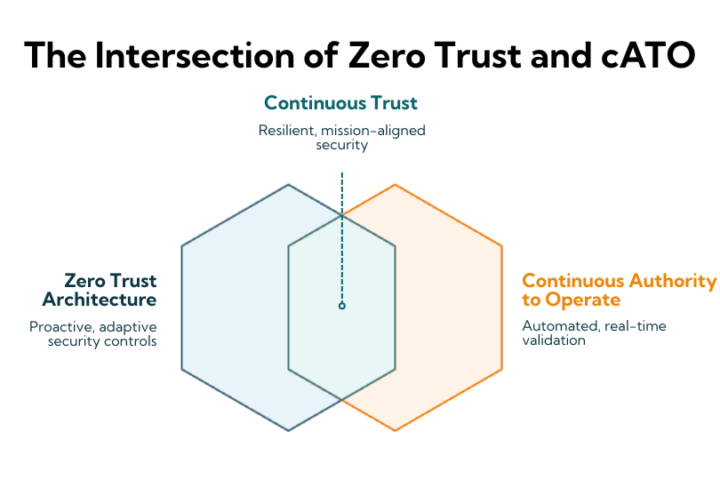As cyber threats grow more sophisticated, federal agencies are shifting from static compliance checklists to dynamic, risk-informed security models. Two of the most powerful strategies reshaping this landscape are Zero Trust Architecture (ZTA) and continuous Authority to Operate (cATO).
Individually, each represents a leap forward. Together, they form the foundation for continuous trust, a security posture that’s resilient, adaptive, and aligned with mission-critical operations.
Zero Trust Assumes Breach. cATO Proves You’re Ready.
Zero Trust is built on the idea that no user, device, or system should be inherently trusted. It enforces identity verification, microsegmentation, and continuous validation across every layer of infrastructure. But ZTA’s effectiveness hinges on the ability to monitor, enforce, and validate those controls in real time.
That’s where continuous ATO comes in.
cATO operationalizes the policies that Zero Trust depends on. It automates the validation of controls, streamlines risk decision-making, and eliminates the stop-start cycle of traditional accreditation.
Together, ZTA and cATO provide a powerful loop:
- ZT sets the security posture through least privilege and assumed breach.
- cATO sustains and proves that posture through automation, telemetry, and governance.

For federal IT leaders, the convergence of ZT and cATO isn’t theoretical, it’s actionable. Agencies can:
- Maintain live system inventories that feed both trust policies and audit readiness.
- Use continuous monitoring tools to detect policy drift and trigger automated POA&Ms.
- Map ZT policy violations to risk tolerances defined in the cATO package.
- Reduce the time and effort of reaccreditation by baking security into day-to-day operations.
In this model, compliance becomes an output of operational security not a separate project.
Case Study: ZT + cATO in a High-Stakes Environment
In one large-scale federal environment supporting over 800 systems and 2 petabytes of data, our team delivered measurable outcomes by integrating ZTA and cATO frameworks.
Using a validated Zero Trust Playbook, we:
- Established comprehensive asset visibility and segmented enclaves
- Enforced identity-aware policies to minimize lateral movemen
- Leveraged BigFix and Graylog to enable real-time monitoring, audit trails, and anomaly detection
- Maintained hardened configurations across multi-platform endpoints, VPNs, and firewalls
This approach enabled the agency to meet FISMA High/Moderate requirements, pass audits with no major findings, and sustain over 95% customer satisfaction without compromising agility or mission alignment. It also set them off on their Zero Trust journey as some key initial steps towards the agencies goals.
Moving Toward Continuous Trust
For agencies seeking to modernize securely, ZT and cATO offer complementary pathways:
- ZT shrinks the threat surface and raises the bar for access
- cATO proves the controls are working, continuously
- Together, they create a real-time view of cyber risk that enables faster decisions, stronger accountability, and greater resilience
At RIVA, we see the convergence of these two frameworks not as a future state, but as a present imperative. With mature tooling, tested frameworks, and deep experience across federal environments, we help agencies move from periodic compliance to continuous trust. If you’d like to learn more about RVA’s approach to continuous trust, reach out to Gerry Caron, VP of Cybersecurity





